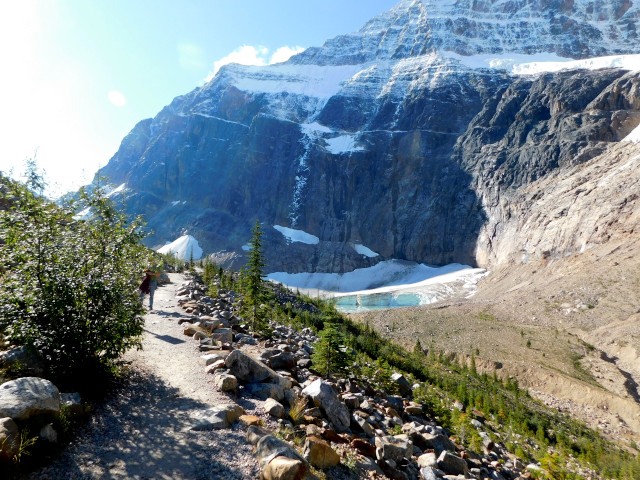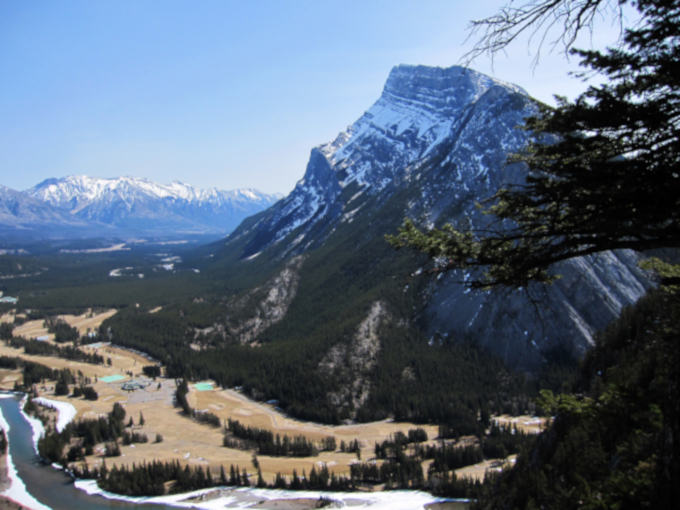
I fell into hiking in the mountains almost by accident, but even at the beginning, it had the pull of destiny about it—that feeling that comes rarely and then with a wash of loveliness: I was born to do this.
It happened in Jasper National Park in 1968, when a convergence of necessities and opportunities gave me a summer of work in the tourist town of Jasper, Alberta. My friend and I had no car, just occasionally borrowed bicycles. Days off became hiking days because we wanted to get out of town, and there was little else to do. I succumbed immediately to the lure of the trail.

Camping began three years later when my husband and I borrowed tents and other equipment to escape to the Rockies where we spent our days hiking trails, sometimes bagging a walk-up peak. Mountain climbers we were not and would never be, lacking both money and nerve. All that was needed for hiking, though, was a map and good boots – and the desire to explore.
Decades later, my husband and I are still camping, still hiking. We hiked with our young sons as soon as we could persuade them to cooperate on the trails (frequent snacks helped!), and now we’re still hiking with them and with our grandchildren as well. I cannot imagine anything more soul-restoring.
This summer, after a year lost to the pandemic, we were finally back in the Rockies, back to Jasper, where it had all begun. Thanks to the pandemic, we were hiking without our family, but we were hiking. We’re slower hikers now than we once were, more tolerant of our limits, more grateful than ever for every heart-stopping view we achieve.

Over the years, our hiking has become more meditative, even creative. In years past, I used to draft entire university course outlines in my mind as we walked in companionable silence. This year, as each scene revived memories of previous hikes, previous adventures, I began thinking of just how much all those beautiful mountain trails have taught us about living thoughtfully and well.
It was Mt. Rundle in Banff that first made life applications explicit.

My husband and I attempted that daunting, supposedly “walk-up,” ascent back in 1973, when our first real hiking boots were still stiff and untried. My older brother, who was with us for a few days and who had done the ascent before, led the way.
Less than an hour from the peak, I lost courage. I could not take another step on that sheer slope of rock. Never mind how often my brother reassured me that my boots would not slide, I couldn’t do it. I resolutely sat myself down on the rock, and informed my husband and brother that I would wait for them. They finished the climb, reveled in the astonishing view, took their pictures, and then returned jubilant. After which, I discovered that going down a mountain is even more unnerving than going up!

As we hiked more often in subsequent years and achieved some high passes in the mountains (adjacent photo is Nigel Pass in Jasper National Park, 2004), I often recalled that “failure” and promised myself that I would get back to Mt. Rundle eventually.
Twenty-two years later, in 1995, when I was facing the last hurdle of my PhD, we returned to Banff, with our two younger sons, now in their teens. I had insisted on that destination that summer because I had made a private bargain with myself: “if I can get to the top of Mt. Rundle, I can finish my dissertation.” I made it, but not easily. The last hour and more was a struggle over loose shale, on which I slid back down with nearly every step up. Mt. Rundle, by pushing me almost to despair, taught me that I could choose to keep putting one foot in front of the other. I also learned the value of not hiking alone; the presence and patience of our sons mattered more than they’ll ever know.
At the top, I hardly knew what was more astonishing—the sight of the entire Bow Valley spread out far below me, or the fact that I was really and truly there.
The following day, I bought a huge poster of Mt. Rundle. For the next year, that poster graced the wall of my tiny study room in the U of S library where I finished writing my dissertation. When I wanted to hurl books at the wall or just give up and go home, I would look at the summit of Mt. Rundle and whisper, “I can do this.”

There have been many other gifts of wisdom that the many hiking trails in the Rocky Mountains have given me. I could, I suppose, write the hiking equivalent of All I Really Need to Know I Learned in Kindergarten.
The worth of the trail itself, for example, never mind what its destination might be. Mt. Rundle was a fantastic goal, but the truth is, there was much to pay attention to throughout the eight or nine hours of the climb and descent. Yes, pay attention—to all of it: the enclosing silence of the forest, not truly silent but rich with the breath of trees, the songs of birds, the scolding of the squirrels, perhaps even the echo of a far-off rock fall; the delicate beauty of lichen, ferns, flowers, insects; the scent of the mountain air; the peacefulness of shifting clouds and the absence of urgency of any kind.
The walking of many trails has taught me much about letting myself be the traveler first of all. The journey itself is the point. Arrival is a bonus. Sometimes spectacularly so.

Which is another way of saying that hiking has changed my perspective in important ways. I am less driven now as a hiker, less anxious to achieve goals, although the prospect of a trail that keeps going up still gives me an adrenalin rush. In our many seasons of hiking I have also learned how to adjust my literal focus.
There is, I’ve found, a time to take in the long view and let myself be inspired by the challenge, and a time to gaze only at the next few feet. Back on our first attempt at Mt. Rundle, I gained considerable altitude simply following my brother’s advice to look only at the back of his boots just ahead of me. To look at the enormous distance between me and the peak was a bad idea. In hiking as in life, it helps to know oneself well enough to gauge when one needs to stare at the ground and when one should look up to the hills.

Hiking in Glacier National Park, BC. 
Trail through Mt. Edith Cavell meadows to a higher ridge.
The exaltation of arrival—at the high ridge, at the glacier-fed lake—comes in three stages for me: first a long-held breath of awe, then happy exclamations—LOOK! We’re here! We made it!—and finally an inner silence, the self-forgetfulness of just being. If the timing of the hike is right, this is the place to combine transcendence with the ordinary ritual (and it feels like a ritual!) of having lunch. It’s the miracle of being alive writ large.
Besides, a lengthy lunchtime postpones that most wrenching moment of the hike, when the hiker has to pick up the pack again and turn his or her back on the glory to begin the return journey. It’s not only that the descent from the high place is going to be hell on vulnerable knees; it’s the knowledge that this moment is rare, precious. Our instinct is to hold on to it.
But it’s not possible to stay there. There are other mountains, there are other journeys, other places in which one must put one foot in front of the other. No matter how stunning the view, sooner or later the good-bye must be spoken (I prefer the German Aufwiedersehen – “until we see each other again”).
Oh, there will be stories to tell afterward. Notice that 26 years and 48 years later, I’m retelling the stories of those two ascents of Mt. Rundle yet again. I no longer have the Mt. Rundle poster; after years of hanging on the walls of my different offices, it was eventually passed on to Value Village. It was time for me to let it go.
The beauty of a mountain is talked about most from a distance . . . .
